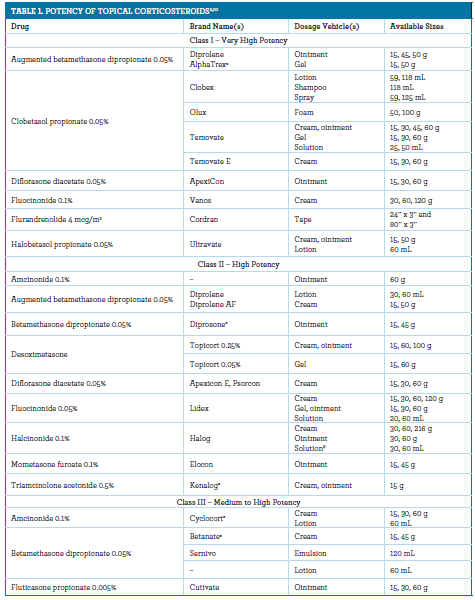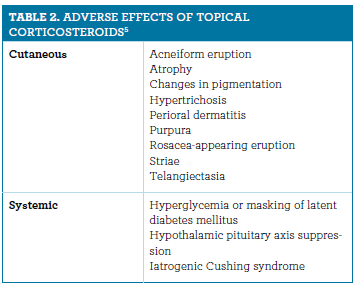Publication
Article
Supplements
Topical Corticosteroids
Topical corticosteroids are available over the counter and are prescribed for a variety of skin ailments ranging from mild and irritating to severe and debilitating.
INTRODUCTION
Topical corticosteroids are available over the counter and are prescribed for a variety of skin ailments ranging from mild and irritating to severe and debilitating. In 2015, 10.6 million prescriptions for topical corticosteroids were processed through Medicare Part D.1 Choice of agent is based on indication and type of lesion, as well as the medication’s potency and application vehicle. Topical corticosteroids can be expensive for patients and the health care system. Although generic formulations are widely available and account for more than 97% of spending between 2011 and 2015, Medicare Part D spent $2.3 billion on this class of agents.1 Topical formulations of these agents are not without potential adverse effects (AEs), but risks vary depending on preparation and duration of therapy.
The anti-inflammatory effects of topical corticosteroids are elicited by reducing the body’s immune response. Corticosteroids bind to receptors in the cytoplasm to form a complex that subsequently enters the nucleus and binds to DNA. This complex regulates gene expression by modulating the transcription of mRNA, which decreases the expression of proinflammatory mediators such as IL-1, IL-2, IL-6, and interferon alpha, resulting in reduced redness, swelling, and irritation of the skin.2 Corticosteroids also exhibit antimitotic activity, making them useful for treating scaling dermatoses.3

Some corticosteroids result in a more potent anti-inflammatory response than others. Topical corticosteroids are grouped into 7 different classes based on their potency, ranging from class I (very high potency), to class VII (lowest potency). These rankings, detailed in table 1, are determined using cutaneous vasoconstriction assays.2,4 Such an assay subjectively evaluates the degree and duration of skin blanching that occurs following topical application. Vasoconstriction has been correlated with clinical efficacy because corticosteroids also reduce the expression of proteins with vasodilatory effects, which leads to skin blanching.2 Because the vasoconstrictor assay is performed in vivo, it accounts for both the intrinsic potency of the drug and the ability of the vehicle to deliver the drug to the intracellular site of action.2
Topical corticosteroids are available in a variety of dosage forms, which allows a treatment regimen to be tailored to a patient’s individual needs. The drug delivery vehicle also contributes to the potency of the formulation. For example, thick, occlusive ointments allow for greater penetration of the drug into the skin over a longer period,5 and are therefore considered more potent than other dosage forms of the same concentration. Ointments are also the most hydrating dosage form because the occlusive barrier that they create helps to protect and moisturize the skin.3 Creams spread more easily than ointments, but may feel greasy on the skin. Gels, foams, and solutions are less oily, but provide little to no hydration and may be irritating due to their alcohol content. Formulations that spread more easily may be preferred for hairy areas.5 Penetration can be improved by applying the preparation right after a shower or bath.5 Patient preference is an important consideration when selecting a delivery vehicle because compliance with topical corticosteroids is low, especially when the cosmetic and tactile aspects of the dosage form are undesirable.6

With the variety of potencies and dosage forms available, the question becomes how to determine the correct therapy for a patient. Often the indication and chronicity of the condition help to guide treatment choices. Lower-potency choices are appropriate for mild dermatitis. These options are the safest for long-term use, for application to large areas of the body, and for areas that may be more sensitive, such as the face, eyelids, and groin area.5 Medium-potency choices may be utilized for more severe cases of dermatitis, as well as eczema and scabies. High-potency choices are usually not used as a first-line option for mild skin conditions and are reserved for more resistant or severe forms of dermatitis or eczema, as well as psoriasis. High-potency ointments are preferred for thick-skinned areas or lesions due to their enhanced penetration.5

Typical treatment frequency of corticosteroids is application once or twice daily4; however, response should be monitored and application titrated to the minimum frequency that provides adequate relief of symptoms. Use of very-high-potency agents should be limited to 3 consecutive weeks, but low- to high-potency agents can safely be used for up to 3 months.5 The amount of steroid to apply is often described in fingertip units (FTUs); 1 FTU is the amount that can be squeezed from the fingertip to the first crease of the finger (about 0.5 g).5 Depending on the area of the body and size of the affected area, application amounts can be estimated using this scale. For example, application to the entire face and neck would equate to about 2.5 FTU.5 Although this is not the most scientific or consistent form of measurement, it is easily recognizable and can help to determine the total amount of medication to be prescribed.5
Some indications for use of topical corticosteroids are more acute in nature, such as a rash from poison ivy or another form of contact dermatitis. However, other, less-acute indications, such as psoriasis, require much longer treatment periods and perhaps lifelong use. Creating an optimal treatment regimen, incorporating recommendations about treatment duration, can be challenging for providers and patients who require chronic management. There are different strategies to consider for these patients, related to tapering and intermittent therapy. Often for acute, symptomatic flares, a higher potency agent will be utilized, followed by stepping down to a lower potency agent for chronic use.7
To avoid rebound exacerbations of more severe skin conditions, it may be beneficial to taper therapy by decreasing the potency of the steroid or dosing frequency in 2-week intervals.5 Once a condition is adequately controlled, the patient may benefit from transitioning to intermittent therapy, such as twice-weekly applications of topical corticosteroids. This strategy has been shown to decrease the rate of relapse for long-term disease control of some disorders and is beneficial in minimizing AEs.4,7,8
Tachyphylaxis is a phenomenon that can be associated with repetitive use of a drug and leads to a decreased clinical response after prolonged or repetitive use.5 Decreased patient adherence to prescribed treatment regimens may also contribute to decreases in efficacy,1,2 which is why judicious choice of agent, duration, and frequency is essential.
Because topical corticosteroids are not a systemic dosage form, they are often thought to be relatively benign and safe. However, their use can result in numerous AEs, especially when they are used for an extended period. Detailed in table 2, the AEs can include cutaneous problems such as purpura, telangiectasia, striae, focal hypertrichosis, and acneiform or rosacea-like eruptions. Skin atrophy is also a concern and is most prevalent with the use of high- and very-high-potency corticosteroids.4 Cutaneous AEs may be minimized with a once- or twice-weekly application of a mid-potency topical corticosteroid.4
Topical corticosteroids can also result in more serious, systemic AEs. Risk factors for systemic AEs include use of high-potency agents, chronic use, application to highly permeable and/or large areas, occlusion of the area, and poor skin integrity.4 Children generally have a greater body surface area to weight ratio, making them more susceptible to systemic AEs of topical corticosteroids.9 The use of high- and very high-potency topical corticosteroids should be avoided in children aged under 12 years.9
One potential major AE of topical corticosteroid use is suppression of the hypothalamic-pituitary-adrenal axis. Signs and symptoms include decreased morning cortisol levels, iatrogenic Cushing syndrome, and hyperglycemia.4,9 Two other rare but serious AEs are glaucoma and cataract formation, which are usually precluded by avoiding application of topical corticosteroids around the eye and eyelid area. Allergic reactions can also develop in response to these agents, but are often related to the vehicle or a preservative in the formulation, not the steroid medication itself.9
CONCLUSION
Topical corticosteroids are the mainstay of treatment for numerous skin conditions including atopic dermatitis, eczema, and psoriasis. A variety of potencies and formulations are available, which allows for individualized therapeutic options. AEs vary based on potency and duration of treatment; therefore, these factors should be carefully considered when evaluating a patient’s treatment.
REFERENCES
1. Song H, Adamson A, Mostaghimi A. Medicare Part D payments for topical steroids: rising costs and potential savings. JAMA Dermatol. 2017 [ePub ahead of print]. doi: 10.1001/jamadermatol.2017.1130.
2. Kirkland R, Pearce DJ, Balkrishnan R, Feldman SR. Critical factors determining the potency of topical corticosteroids. J Dermatolog Treat. 2006;17(3):133-135. doi: 10.1080/09546630600845370.
3. Miller JA, Munro DD. Topical corticosteroids: clinical pharmacology and therapeutic use. Drugs. 1980;19(2):119-134.
4. Eichenfield LF, Tom WL, Berger TG, et al. Guidelines of care for the management of atopic dermatitis: section 2. management and treatment of atopic dermatitis with topical therapies. J Am Acad Dermatol. 2014;71(1):116-132. doi: 10.1016/j.jaad.2014.03.023.
5. Ference JD, Last AR. Choosing topical corticosteroids. Am Fam Physician. 2009;79(2):135-140.
6. Tan X, Feldman SR, Chang J, Balkrishnan R. Topical drug delivery systems in dermatology: a review of patient adherence issues. Expert Opin Drug Deliv. 2012;9(10):1263-1271. doi: 10.1517/17425247.2012.711756.
7. Lee JH, Son SW, Cho SH. A comprehensive review of the treatment of atopic eczema. Allergy Asthma Immunol Res. 2016;8(3):181-190. doi: 10.4168/aair.2016.8.3.181.
8. Hanifin J, Gupta AK, Rajagopalan R. Intermittent dosing of fluticasone propionate cream for reducing the risk of relapse in atopic dermatitis patients. Br J Dermatol. 2002;147(3):528-537.
9. Hengge UR, Ruzicka T, Schwartz RA, Cork MJ. Adverse effects of topical glucocorticosteroids. J Am Acad Dermatol. 2006;54(1):1-15;quiz 16-18. doi: 10.1016/j.jaad.2005.01.010.
10. Lexicomp Online. Wolters Kluwer Clinical Drug Information website. http://www.wolterskluwercdi.com/lexicomp-online/. Accessed June 5, 2017.
Natalie Gadbois, PharmD, MPA, is a PGY-1 Pharmacy Practice Resident at Iowa Methodist Medical Center, Des Moines, Iowa.Kellie Arensman, PharmD Candidate 2018, is a student pharmacist at Drake University College of Pharmacy and Health Sciences, Des Moines, Iowa.







